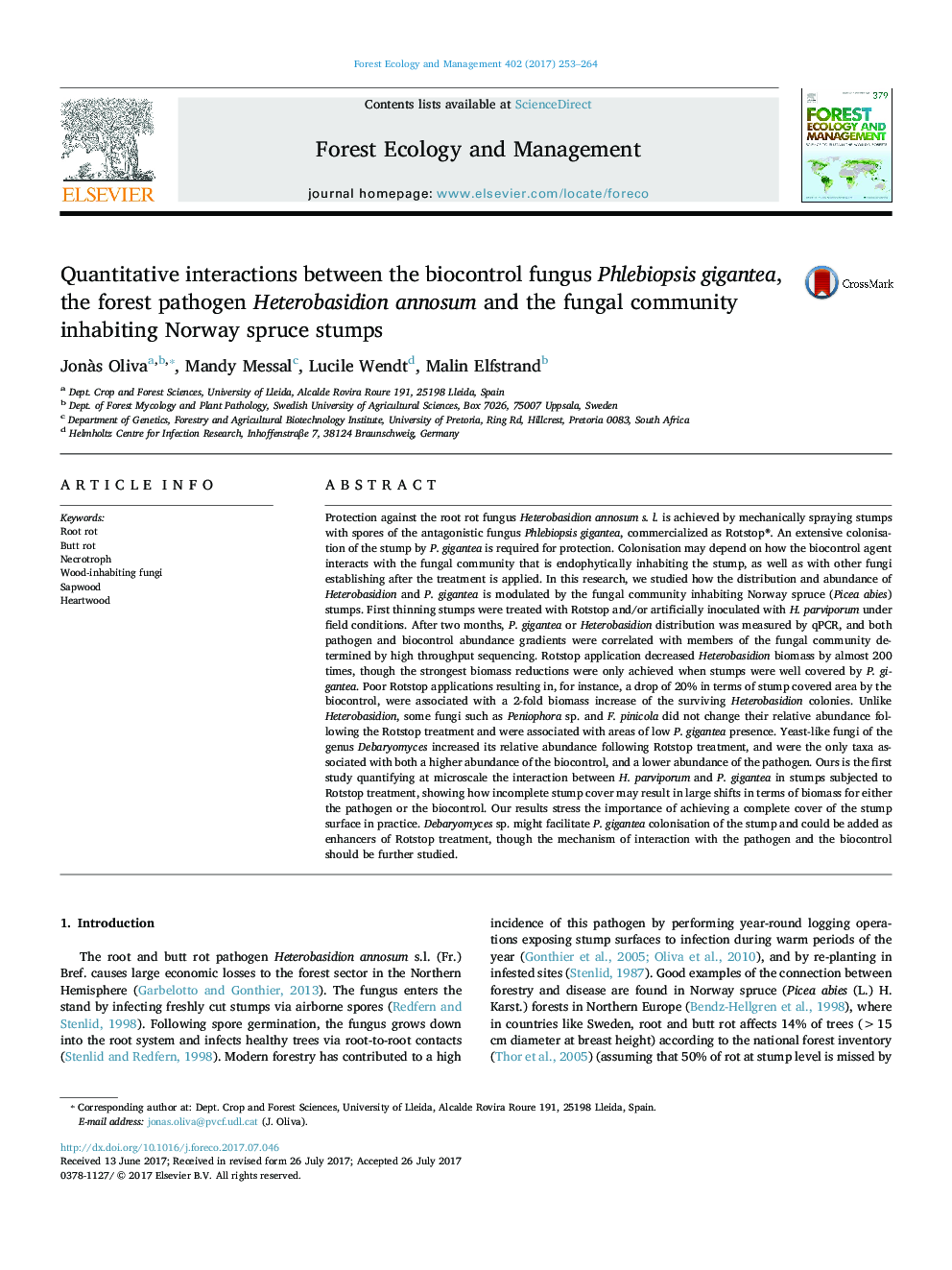| کد مقاله | کد نشریه | سال انتشار | مقاله انگلیسی | نسخه تمام متن |
|---|---|---|---|---|
| 4759358 | 1421356 | 2017 | 12 صفحه PDF | دانلود رایگان |
عنوان انگلیسی مقاله ISI
Quantitative interactions between the biocontrol fungus Phlebiopsis gigantea, the forest pathogen Heterobasidion annosum and the fungal community inhabiting Norway spruce stumps
دانلود مقاله + سفارش ترجمه
دانلود مقاله ISI انگلیسی
رایگان برای ایرانیان
کلمات کلیدی
موضوعات مرتبط
علوم زیستی و بیوفناوری
علوم کشاورزی و بیولوژیک
بوم شناسی، تکامل، رفتار و سامانه شناسی
پیش نمایش صفحه اول مقاله

چکیده انگلیسی
Protection against the root rot fungus Heterobasidion annosum s. l. is achieved by mechanically spraying stumps with spores of the antagonistic fungus Phlebiopsis gigantea, commercialized as Rotstop®. An extensive colonisation of the stump by P. gigantea is required for protection. Colonisation may depend on how the biocontrol agent interacts with the fungal community that is endophytically inhabiting the stump, as well as with other fungi establishing after the treatment is applied. In this research, we studied how the distribution and abundance of Heterobasidion and P. gigantea is modulated by the fungal community inhabiting Norway spruce (Picea abies) stumps. First thinning stumps were treated with Rotstop and/or artificially inoculated with H. parviporum under field conditions. After two months, P. gigantea or Heterobasidion distribution was measured by qPCR, and both pathogen and biocontrol abundance gradients were correlated with members of the fungal community determined by high throughput sequencing. Rotstop application decreased Heterobasidion biomass by almost 200 times, though the strongest biomass reductions were only achieved when stumps were well covered by P. gigantea. Poor Rotstop applications resulting in, for instance, a drop of 20% in terms of stump covered area by the biocontrol, were associated with a 2-fold biomass increase of the surviving Heterobasidion colonies. Unlike Heterobasidion, some fungi such as Peniophora sp. and F. pinicola did not change their relative abundance following the Rotstop treatment and were associated with areas of low P. gigantea presence. Yeast-like fungi of the genus Debaryomyces increased its relative abundance following Rotstop treatment, and were the only taxa associated with both a higher abundance of the biocontrol, and a lower abundance of the pathogen. Ours is the first study quantifying at microscale the interaction between H. parviporum and P. gigantea in stumps subjected to Rotstop treatment, showing how incomplete stump cover may result in large shifts in terms of biomass for either the pathogen or the biocontrol. Our results stress the importance of achieving a complete cover of the stump surface in practice. Debaryomyces sp. might facilitate P. gigantea colonisation of the stump and could be added as enhancers of Rotstop treatment, though the mechanism of interaction with the pathogen and the biocontrol should be further studied.
ناشر
Database: Elsevier - ScienceDirect (ساینس دایرکت)
Journal: Forest Ecology and Management - Volume 402, 15 October 2017, Pages 253-264
Journal: Forest Ecology and Management - Volume 402, 15 October 2017, Pages 253-264
نویسندگان
Jonàs Oliva, Mandy Messal, Lucile Wendt, Malin Elfstrand,